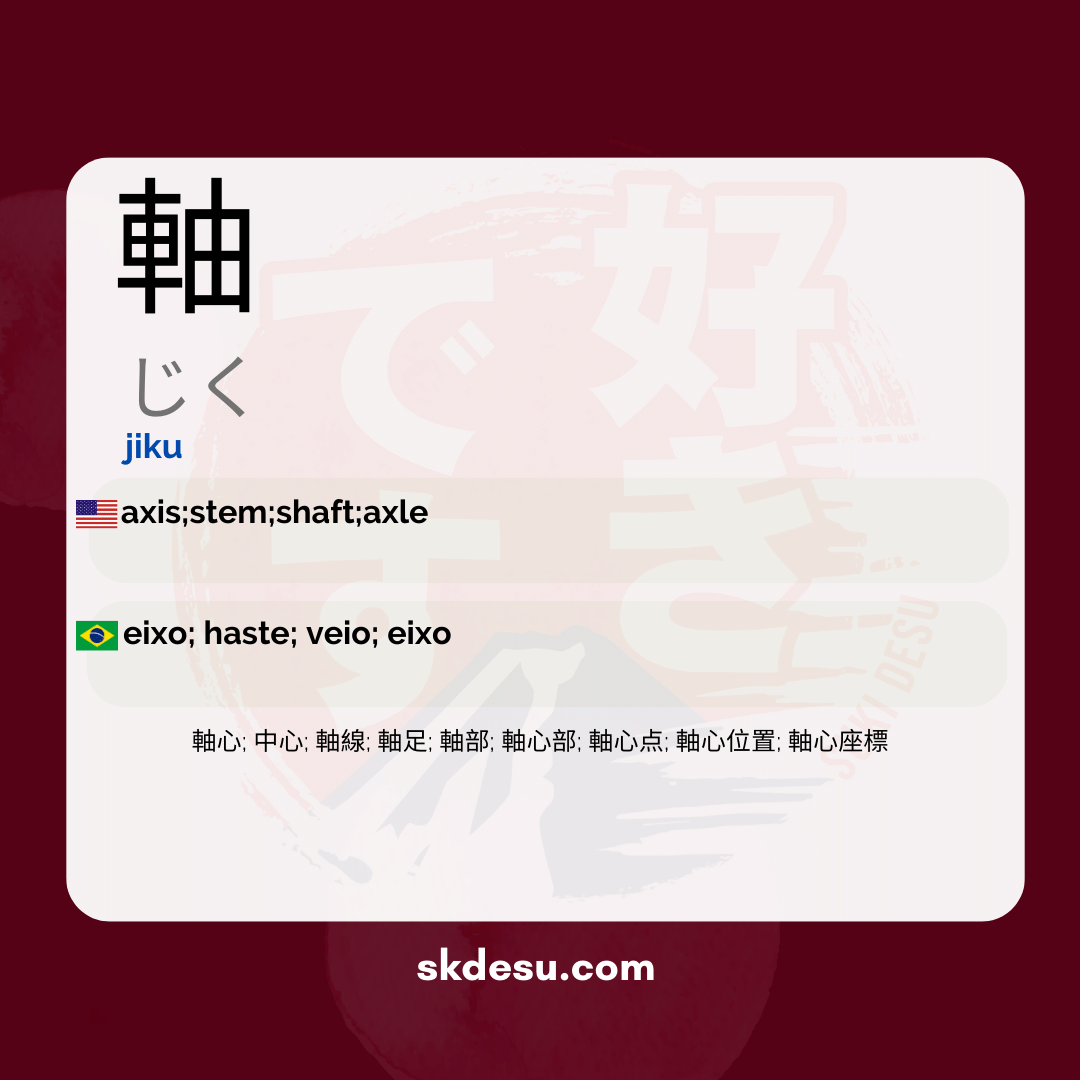Translation and Meaning of: 軸 - jiku
The Japanese word 軸[じく] (jiku) may seem simple at first glance, but it carries deep meanings and various applications in the language. Whether you are a Japanese language learner or just a curious person about the language, understanding the use and importance of this word can open doors to a richer understanding of Japanese culture. In this article, we will explore its meaning, origin, and how it is used in daily life, as well as tips for memorizing it effectively.
The term 軸[じく] is a versatile term, present in contexts ranging from the physical world to the abstract. Whether in machines, structures, or even in philosophical discussions, this word plays a fundamental role. Here, you will discover not only its literal translation but also how it fits into different situations, including common expressions and its impact on Japanese communication.
Meaning and translation of 軸[じく]
The most direct translation of 軸[じく] is "axis," referring to a central component that supports or rotates something, such as a wheel axle or the Earth's axis. However, its meaning goes beyond the physical sense. In abstract contexts, the word can represent a "pillar" or "foundation" of an argument, idea, or organization, indicating something essential that keeps the structure cohesive.
For example, in a company, the term can be used to describe a fundamental principle that guides decisions. Similarly, in philosophical discussions, 軸[じく] can symbolize a central concept around which other ideas revolve. This duality between the concrete and the abstract makes the word widely used in different fields of knowledge.
Origin and writing of the kanji 軸
The kanji 軸 is composed of two radicals: 車 (kuruma), which means "car" or "vehicle," and 由 (yoshi), which can represent "reason" or "origin." This combination suggests the idea of an axis that enables movement, like the axle of a wheel. The presence of the radical 車 reinforces the connection of the word with mechanical objects and structures that rotate or support weight.
Although the origin of kanji refers to physical contexts, its use has expanded to broader meanings over time. This evolution reflects how the Japanese language adapts concrete terms to express abstract concepts while maintaining a connection to their original root. Studying the composition of kanji can aid in memorization, especially for those learning Japanese.
Everyday use and common expressions
In daily life, 軸[じく] appears in various situations, from technical conversations to strategic discussions. In engineering, for example, it's common to hear phrases like "この機械の軸が壊れた" (The axis of this machine is broken). In business contexts, someone might say "このプロジェクトの軸を決めよう" (Let's define the focus of this project), using the word in the sense of the main direction.
An interesting expression that includes 軸[じく] is 人生の軸 (jinsei no jiku), which means "the axis of life" and refers to the core principles or values that guide a person. This construction demonstrates how the word can be applied metaphorically, reinforcing its importance in both practical and philosophical discourse.
Tips for memorizing 軸[じく]
An effective way to fix this word is to associate it with objects that have a physical axis, such as wheels or revolving doors. Visualizing the kanji 軸 also helps, as the radical 車 (car) directly reminds one of the idea of movement and support. Repeating phrases like "この車の軸は丈夫だ" (The axis of this car is sturdy) can consolidate the learning.
Another strategy is to create flashcards with usage examples in different contexts, alternating between concrete and abstract meanings. Apps like Anki are great for this purpose, allowing spaced repetitions that improve retention. The more you practice with real examples, the more natural the use of 軸[じく] will become in your vocabulary.
Vocabulary
Expand your vocabulary with related words:
Synonyms and similar words
- 軸心 (Jikushin) - Center of the axis, central point of a rotating structure.
- 中心 (Chūshin) - Center, the central part of an object or concept; it can be used in a broader context.
- 軸線 (Jikusen) - Axis line refers to a line that passes through the axis of an object or motion.
- 軸足 (Jikuashi) - Axis foot, referring to the support point or base of an axis.
- 軸部 (Jikubu) - Part of the axis, indicating a section or component of the axis in question.
- 軸心部 (Jikushinbu) - Central part of the axis, specifically the internal section that contains the center of the axis.
- 軸心点 (Jikushin-ten) - Central point of the axis, reference to a specific point in the middle of the axis.
- 軸心位置 (Jikushin ichi) - The central position of the axis refers to the location of the axis center in a three-dimensional space.
- 軸心座標 (Jikushin zahyō) - Coordinates of the central axis point, used in mathematical or engineering contexts to locate the center of the axis.
Related words
heikou
(indo) side by side; simultaneously; beside; at the same time; occur together; parallel; parallelism
Romaji: jiku
Kana: じく
Type: noun
L: jlpt-n1
Translation / Meaning: axle; stem; he came; axle
Meaning in English: axis;stem;shaft;axle
Definition: The central axis of things. Or the axis of rotation.
Quick Access
- Vocabulary
- Writing
- Sentences
How to Write in Japanese - (軸) jiku
See below a step-by-step guide on how to write the word by hand in Japanese. (軸) jiku:
Example Sentences - (軸) jiku
See below some example sentences:
Jiku wa kaiten suru
The axis spins.
- 軸 (jiku) - axis
- は (wa) - Topic particle
- 回転する (kaiten suru) - spin, rotate
Other Words of this Type: noun
See other words from our dictionary that are also: noun

